Rhodes is an island rich in history due to the number of ancient empires that occupied it throughout the centuries. Its distinctive history began in the Stone Age with the inhabitation of the Cretans. It was then occupied by the Phoenicians as early as 1500 B.C. A century later, the Mycenaeans came over from Achaea, bringing with them the Greek language and the first traces of ancient Greek culture. It was not until the Dorians conquered the island sometime around 1100 B.C. that the island’s three principle ancient cities were established: Ialyssos, Lindos, and Kamiros. They would ultimately combine forces to create one powerful entity.
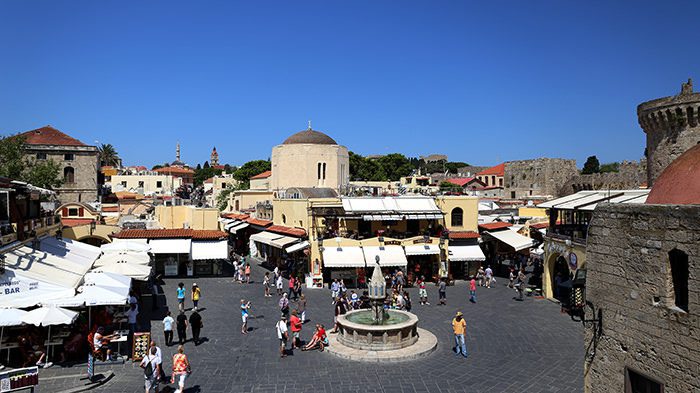
Rhodes’ location was advantageous for trade. Over the centuries, it had a strategic position along major trade routes moving in all directions. Rhodes Greece played an essential role in trade between Sicily, Argolis, Cyclades, Cyprus, Syria, the Ionian coast of Asia Minor, and Egypt. This would ultimately draw the attention of numerous greedy empires, eager to control such an economically promising position of international power and prestige. In 490 B.C. the island’s promise and wealth caught the eye of Persia, and fell victim to their attacks.
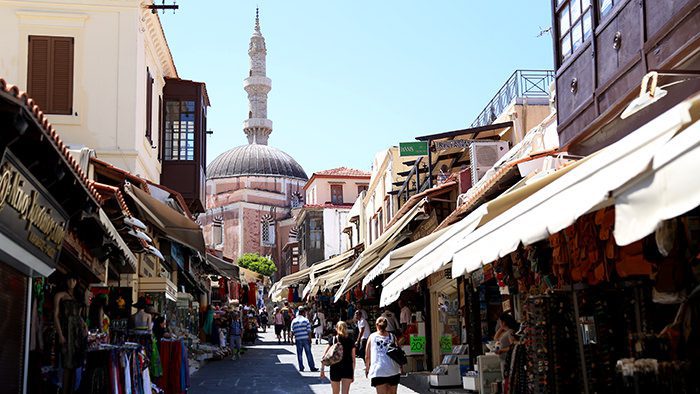
Over the years, the island continued to rise and fall at the hands of numerous empires. It fell to the hands of Seljuks of Haroun al Raschid in the 9th century, fell under rule of the Crusaders for some time, then once again back to the Byzantines. All of whom left their mark on the island, and all of whom contributed to the historically fascinating sites and history of Rhodes. However, most of the island’s historical character and impressive buildings were left behind by the Knights of Saint John, who took over the island circa 1309.

Their influence can still be seen in the impregnable fortresses, acropolises, churches, and numerous other ancient constructions sprinkled throughout the island. Historically, much can be learned from the endurance and adaptation of Rhodes. Subjected to invasion after invasion, and multiple devastating earthquakes, the people of the island continued to rebuild and flourish time and time again, until, at long last, it grew into the culturally rich and internationally cherished destination that it is today.
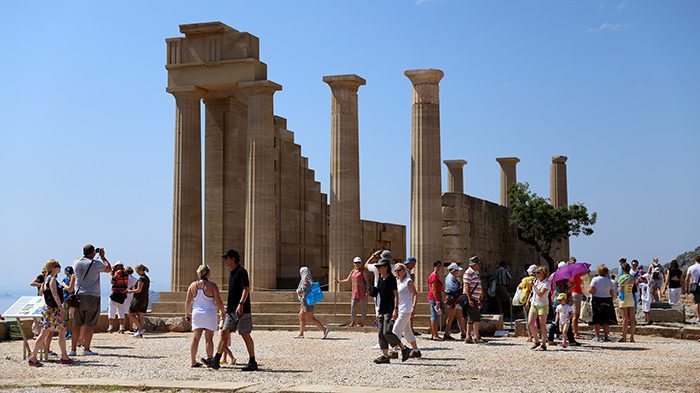
Geographically, the island is diverse. It is situated adjacent to the coast of Turkey in the southeastern corner of the Aegean Sea. Covering 541 square miles, Rhodes is the largest of the Dodecanese Islands. It is distinguishingly shaped like a spearhead, with the northernmost point being occupied by the capital, Rhodes Town. The interior of the island is mountainous and forested with pine and cypress trees. Quaint mountain villages and beautiful terrain dominate the center of the island, while the framing shores, particularly the eastern coast, are lined with coastal towns that lure in tourists during the busy summer months.

The rockier shores of the western coast are picturesque but significantly less populated and thus attract fewer visitors. Rhodes enjoys a subtropical and mild climate year round. Even during the summer months, a light breeze will often help to assuage the oppressive midday heat. Rhodes has an average of 300 days of sunshine a year.
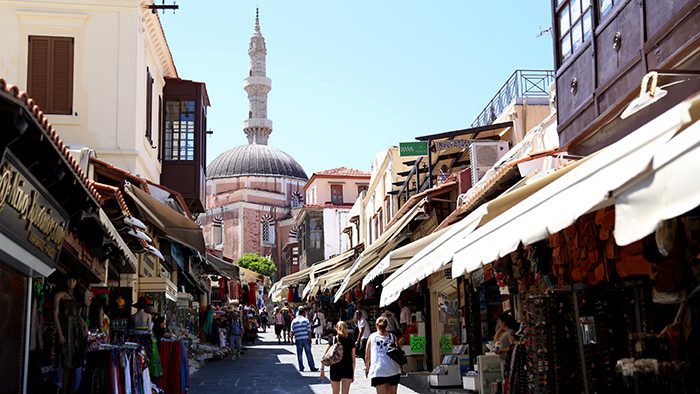
In recent years, Rhodes has experienced an unprecedented boom in tourism. Regardless, Rhodians have proven themselves quick to adapt, and the island has risen to the challenge. Within a matter of years, Rhodes transformed itself into one of the most sought out tourist destinations in the Aegean. Every year more resorts sprout up along its shores, and restaurants of a wide variety have been implemented to appeal to all palates. The ever-increasing influx makes sense for the simple reason that Rhodes’ most appealing attribute is that it truly does have something to offer everyone. Rhodes has 43 towns and villages.
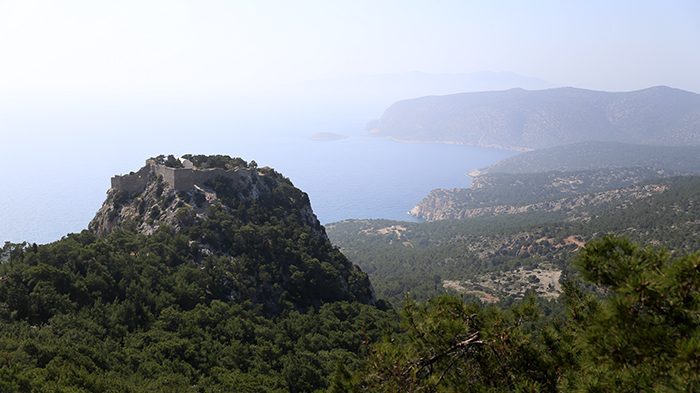
Beach towns provide refuge to over-studied, vacationing college students. High-end, luxury resorts line the shores of eastern beach towns, providing a secluded ambiance for couples and honeymooners. Tranquil beaches and peaceful mountain villages are perfect for vacationing families. A plethora of wineries occupy the island’s highland, luring in wine buffs from near and far with their unique flavors and economical prices. Water sport enthusiasts are drawn to some of Rhodes’ choppier shores, while sunbathers are content to bask in cool blue bays framed by warm golden sands.
Castles amongst other impressionable ruins appeal to history lovers, and the island’s mastery of all things seafood is guaranteed to keep any foodie content. With so much to offer in the means of culture, history, geography, and gastronomy, it is no wonder that Rhodes has landed itself at the top of many bucket lists. Here are 15 Things to See and Do in Rhodes Island, Greece!

Rhodes Town is the capital of the island. It is technically a city, and it occupies the northernmost tip of Rhodes, containing roughly sixty percent of the island’s entire population. Rhodes forms the foundation of the island’s culture and tourism industry, and serves as the gateway to the island. In 1309, The Order of the Knights of Saint John successfully took over the island. Their revamping and constructions were to take place continuously for the next two hundred years.
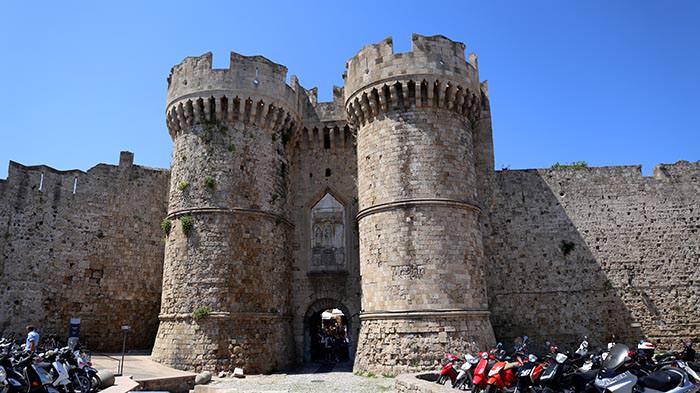
Undeniably, their greatest contribution to Rhodes was the walled city, known as Rhodes Old Town. Encircled by impressive stone walls, and guarded by several towers and moats, it is the oldest continuously inhabited medieval City or Town of Europe, and the island’s most alluring attraction. The best way to take in the old town sights is by foot. All attractions within Rhodes Old Town are walking distance from each other.
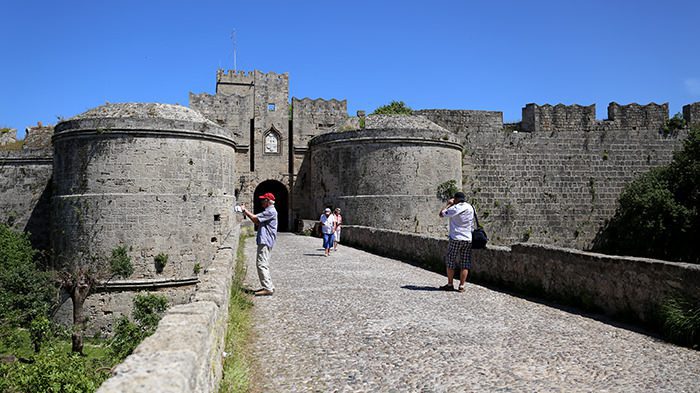
Those who have rented a car should keep in mind that only residents are permitted to drive within the walls, though there is plenty of metered parking along the exterior. Exceptions apply to taxis dropping off and picking up visitors at their hotels. The cobblestone streets of Rhodes Old Town are ideal for strolling, and the narrow walkways are lined with plenty of restaurants, cafés, and boutique shops to keep you busy. Keep in mind that there are many streets with no name.
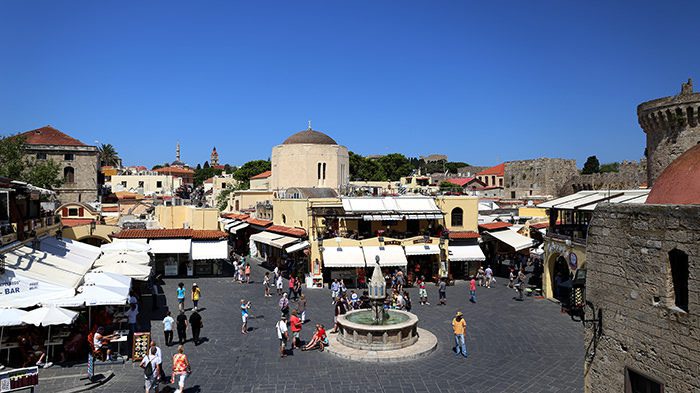
Upon entering through Marine Gate (Agias Ekaterinis) you will find yourself in Hippokratous Square. This is a good point from which to begin exploring Rhodes Old Town. The square is a bustling meeting point surrounded by cafés, shops, and open-air restaurants. From here you have direct access to the shopping street, Sokratous. Hippokratous Square is also home to the 16th century Castellania, which was used as a criminal court. Nowadays it serves as the public library and historical archive.

Heading north through the upper old town, in front of Liberty (Eleftherias) Gate, is Symis Square. Here are the ancient ruins of the third century B.C. Temple of Aphrodite. Head back towards the center of the old town to Ipoton Street, or Street of the Knights. This is where the Knights had their lodges and where dignitaries were hosted. Each of the seven inns represented the seven countries the Knights came from. Only the Inn of France is open to the public (Monday through Friday 8 a.m. to noon). The Street of the Knights leads to the Palace of the Grand Master, the most significant monument within the walls (summers: 8 a.m. to 7:40 p.m. Tuesday to Sunday, Monday 9 a.m. to 3:40 p.m. / Winters: 8:30 a.m. to 3 p.m. Tuesday to Sunday, closed Mon
days / +30 22413 65270 / Price €6, 18 and under free).

The Grand Master Palace was destroyed in a gunpowder explosion in 1856. Thankfully, the Italian’s came to the rescue, rebuilding it with great attention to detail and sparing no expense. The once-again lavish palace now serves as a museum and UNESCO World Heritage Site. Highlights include antique furnishings, mosaic floors brought over from the excavations of nearby Kos Island, and a permanent ground floor exhibit about Rhodes from the early Christian period to the Turkish conquest in 1522.
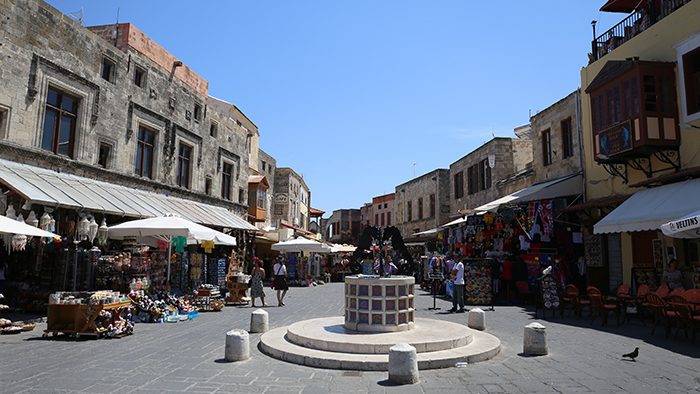
The Archeological Museum (+30 22413 65256 / Price €6) is a great value and a must for history buffs. Located within the old hospital of the Knights, along the Street of the Knights, the Archaeological Museum contains an impressive collection of ancient sculptures, mosaics, pottery, coins, jewelry, vases, as well as an outdoor garden and interior courtyard. Artifacts range from the prehistoric to the early Christian period. Not too far away from the Archaeological Museum is the Decorative Arts Collection (+30 22413 65200 / Price €3) in Plateia Argyrokastrou. Housed within the old vaulted arsenal of the Knights, the museum exhibits traditional embroidered costumes, ornate plates, antique furniture, ceramics, textiles, and utensils from the Dodecanese Islands spanning from the 16th to the early 20th centuries.

Near Hippokratous Square is the Square of the Jewish Martyrs, which is often referred to as “Seahorse Square” because of the charming seahorse fountain located here. Here is the Holocaust Memorial of Rhodes commemorating the 1,604 Jews of Rhodes who were sent to the Auschwitz concentration camp. Many visitors don’t realize that the square lies in the heart of the old Jewish Quarter, or “La Juderia.” Prior to WWII there were over 4,000 Jews living in Rhodes, but nowadays that number is down to about 30. The Jews who lived here were Sephardic Jews that fled the Inquisition in Spain. They spoke Ladino; an ancient Judeo-Spanish language that developed as a result of their years living in Spain.
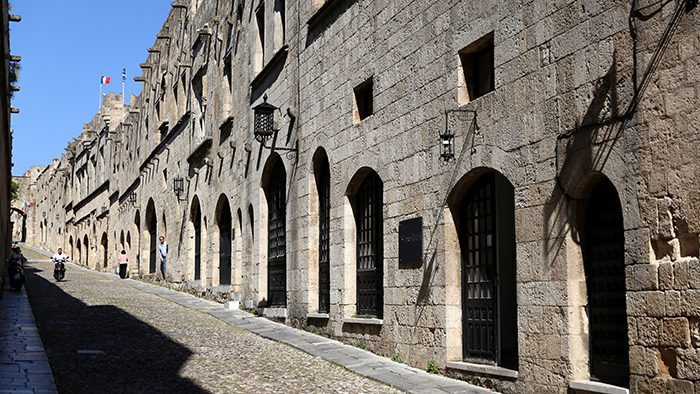
La Juderia of the old town still contains many family homes and business, which have been since converted into restaurants, boutique hotels, and shops. La Juderia is home to Greece’s oldest synagogue, Kahal Shalom Synagogue. Inaugurated in 1577, it is the island’s only remaining synagogue of the original six. The website is a fantastic resource curated by the Jewish Museum of Rhodes. Here you’ll find more information about the history of the neighborhood and the museum.
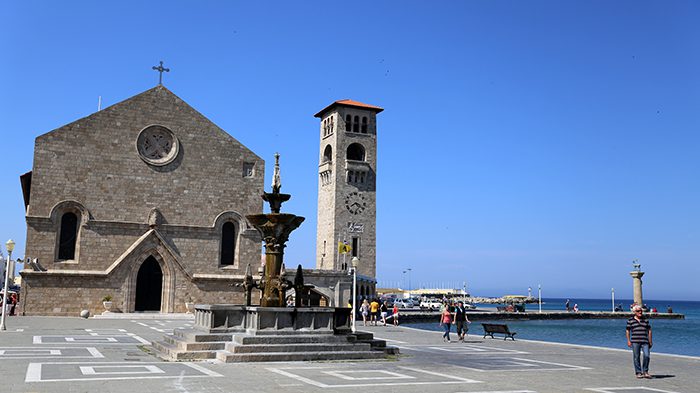
Much of the island’s later Turkish influences are housed in Hora neighborhood, including a number of Muslim houses of worship. The most notable of these is the Mosque of Süleyman. Constructed in 1522, it is hard to miss due to its brightly colored pink dome. The neighborhood’s gender-divided Hammam Turkish Baths are also housed within the Hora.
Tip: Old Town Rhodes was not designed like a grid. You may get a little lost from time to time if you wander away from the main squares, but don’t worry; getting lost will give you the opportunity to explore the charming streets and dead ends. If you get lost, just ask a local to point you in the right direction.

A walk around Mandraki Harbor is a pleasant one. Although its precise location remains a mystery, here is where the ancient Colossus of Rhodes once stood. Many believe the behemoth bronze statue of the Greek titan Helios stood at the entrance of Mandraki Harbor, but that would have blocked the harbor entrance to large ships. It was probably located somewhere in the eastern part of the harbor or further inland. The Colossus of Rhodes took twelve years to construct from 304 to 292 B.C.
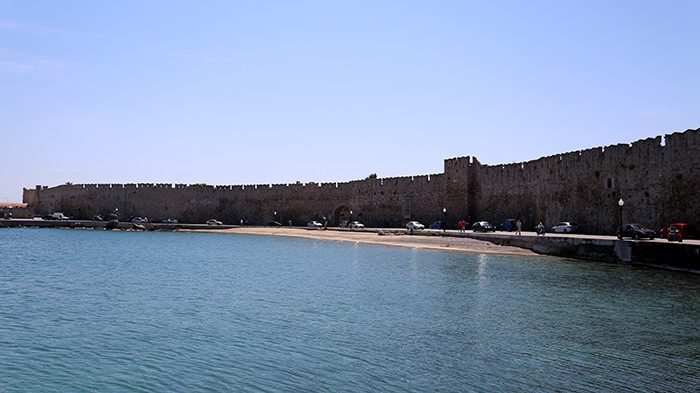
The man responsible for the feat was the sculptor Chares of Lindos. When finished, the statue measured 110 feet (33 meters). An earthquake in 226 B.C. sent the statue tumbling into the harbor, where it lay, in pieces, for over 1,000 years before being transported to Syria by Arab invaders in 654 A.D. Although accounts of what the statue looked like differ, the consensus still is that the Colossus of Rhodes is regarded as one of the Seven Wonders of the Ancient World. North of the old town walls, bordering Mandraki Harbor, is the 15th century Fortress of Saint Nicholas. It served as the key defense point for the harbor and the walled city.
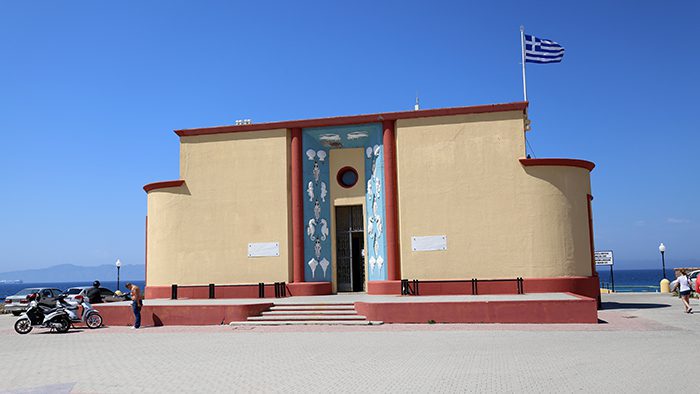
Beyond the protective walls of Rhodes Old Town, the New Town spans out in every direction. Modern condominiums and concrete buildings provide a stark contrast to the ancient history that still resonates within the historical barrier of the original city. It is here that you will find an excessive wealth of accommodations and tour agencies. Those traveling with kids should not miss out on the Rhodes Aquarium-Museum (Summers: 9 a.m. to 8:30 p.m. / Winters: 9 a.m. to 4:30 p.m. / Price €5.50 adults, Reduced €2.50). Nautical residents include mollusks, crabs, and sea turtles. It is a great opportunity to get in touch with Rhodes’ deep-seeded ties to the sea.
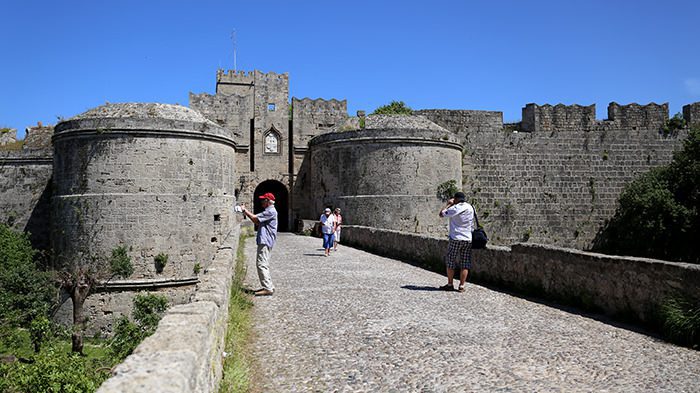
Dating from the Hellenistic Period (2nd-3rd centuries B.C.), the Acropolis of Rhodes was once the most significant acropolis on the island. This predominating ancient section of the town rests to the west of the city on Saint Stefanos Hill, the highest point in Rhodes Town. The Italians began excavations in 1912, and continued until the end of World War II. However, much of the site remains unexcavated. As such, the area is protected and new constructions are prohibited since more is yet to be revealed. During the acropolis’ glory days, it was not fortified. This sets it apart from many of the island’s other surviving acropolises.
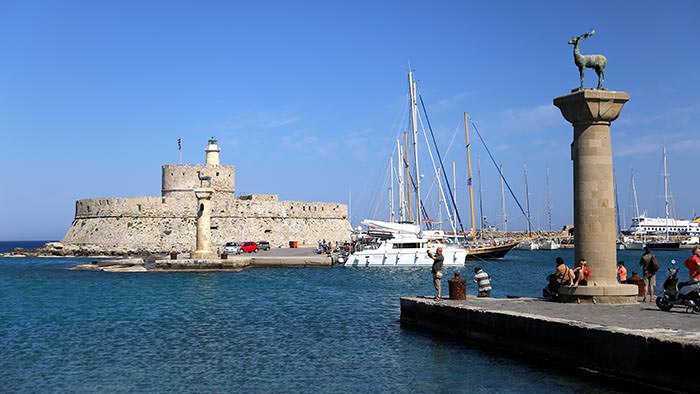
Rather than serve as the town’s main defense, it served as the religious and political center, complete with sanctuaries, temples, and all of Rhode’s key public buildings. The Temple of Apollo is amongst the site’s reconstructed ruins. It rests above the also noteworthy amphitheater and stadium. Additional points of interest include the library, the gymnasium, and The Temple of Athena Polias and Zeus Polieus. The site is perfect for anyone who appreciates ancient Greek history, and untainted panoramic views amongst a quieting natural backdrop.
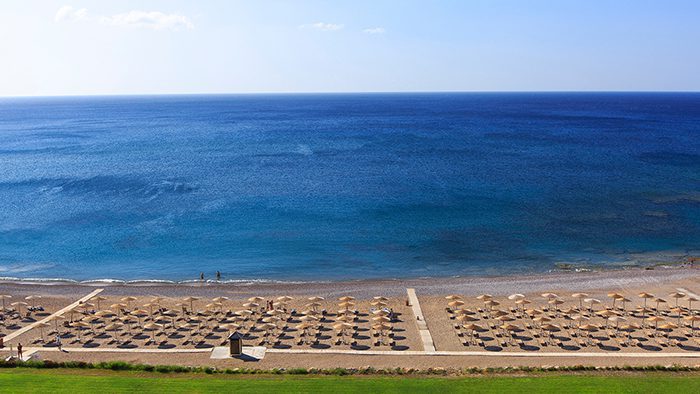
Faliraki Beach is arguably the islands most touristic city. Miles of beach are lined with all-inclusive resorts, luxury villas, water parks, and restaurants. Visitors should keep in mind that Faliraki boasts a dichotomous ambiance. At night, the area’s pulsing nightlife makes it a big hit with vacationing college students and backpackers looking to let loose. For partygoers, there is both a Bar Street and a Club Street! By contrast, families wander the shore during the day, taking advantage of all of the family-friendly fun that Faliraki has to offer. Unlike the limited options of Kolymbia (see below), Faliraki’s shore is lined with a bounty of restaurants, shops, and brightly colored umbrellas complete with lounge chairs.
Check out The Best Beaches in Rhodes Island
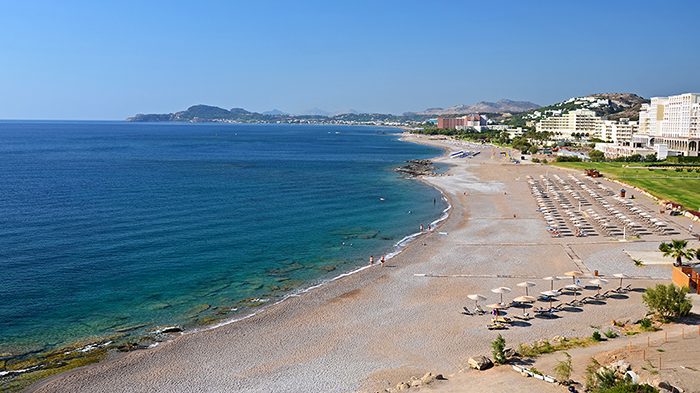
Popular water sports include windsurfing and waterskiing, though there are also paragliding and Bungee jumping opportunities for adrenaline seekers. The southern end of the beach boasts softer sands and more beach furniture. While there is nothing quiet about Faliraki, those looking for a slightly less populated strip of shore should wander down to the two smaller bays at the far southern end. If for some absurd reason you should run out of things to do, you can check out the snakes at the local snake farm, join in on a game of beach soccer, or race some go-karts.
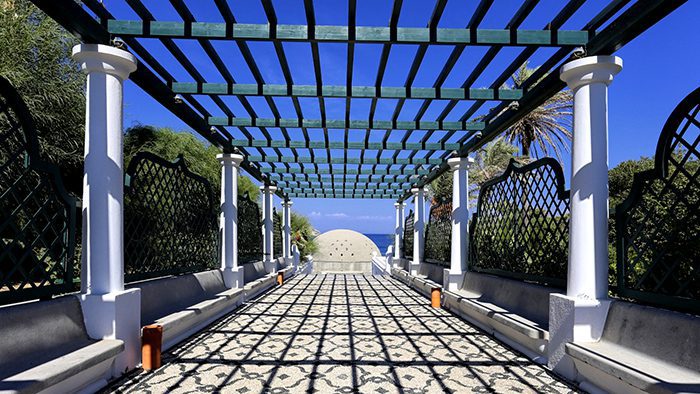
There are two extremes for accommodations. Tourists can choose to stay in one of the big hotels lining the coast, or they can head to the outskirts of town where there are rooms and apartments available for rent. While the rooms and apartments are farther from the water, they are a ess touristy, quieter option. Even if you don’t stay overnight, the beaches of Faliraki and nearby Kalithea (located nine miles from Rhodes Town, north of Faliraki Beach) are great day trip options from Rhodes Town, with plenty of restaurants dishing up both Greek and international cuisine.

Another great reason to visit Kalithea Beach is the spectacular Kalithea Springs Roman bath spa complex. Since opening in 1929, Kalithea Springs is a luxurious retreat where guests can enjoy the therapeutic waters from the area’s natural springs, swim and sunbathe in the lagoon, enjoy a cocktail under a parasol, or check out the historical exhibition of photos. Entrance fee is just €3.
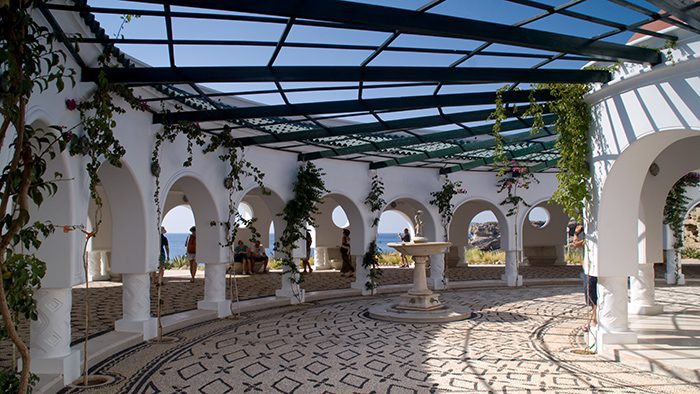
Local parks include Luna Park and Faliraki Water Park. From May to October, Luna Park opens its doors at 7 p.m. and the fun does not stop until 1 a.m. This fanatically fun fair houses rides that are appropriate for visitors of all ages. Consequently, Faliraki’s water park is owned and ran by the same company, so visitors can rest assured that the water park dishes up fun of no less a caliber. The park’s most alluring feature is the eleven exhilarating slides, though there are other attractions such as a wave pool and a lazy river.

The Valley of the Butterflies (Petaloudes) is located just over fourteen miles from Rhodes Town, and is a must see for appreciators of natural beauty and lovers of Mother Nature’s most beautiful insect. The area is popular for its breathtaking natural surroundings, as well as the millions of butterflies who call the park home. This includes the stunning tiger moths that flourish during the summer months. Visitors are welcome to snap pictures of these delicate creatures as they lounge in and amongst the trees and bushes. Please note that capturing, killing, or disturbing the butterflies in any way is illegal!

The park boasts a number of peaceful trails that visitors are welcome to explore rhodes on foot. Pack a picnic and bring the whole family for a peaceful afternoon to remember. Moni Kalopetra Monastery is situated overlooking the park, and complete with pubic picnic tables. There are footpaths leading up to the monastery. However, it is possible to drive directly up to the monastery, park there, and follow the paths down into the park. Keep in mind that the butterflies are actually only present from the end of June through until late August, though the park’s waterfalls, penetrating stream, rock pools, and wealth of picturesque resting places make The Valley of the Butterflies worth a visit year round.
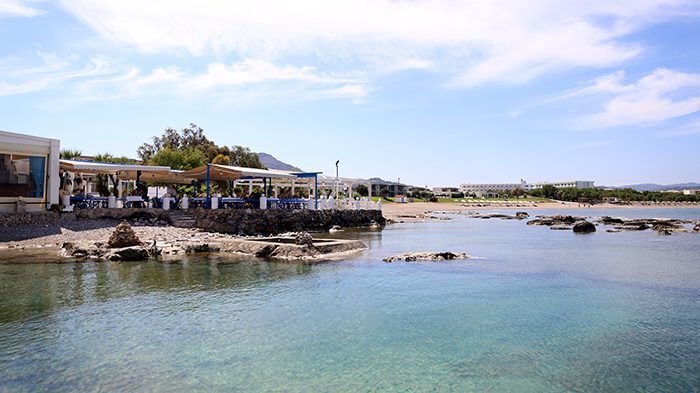
Kolymbia is a quiet coastal village located half way between Rhodes Old Town and Lindos on the eastern side of the island. Reach Kolymbia by following the refreshingly scented Eucalyptus Road. It is a low-key retreat when compared with some of the island’s more cosmopolitan cities, and as such it is home to relatively few businesses and attractions. However, its proximity to Faliraki and Rhodes Town make it ideal for those who like to be close to the action, but not directly in the middle of it.

We recommend Kolymbia for couples looking for a romantic retreat, or those traveling with small children. The beautiful beaches and local restaurants are the highlight of the town for those in need of quiet relaxation and simple some fun in the sun. Accommodations are plentiful, conveniently located along the main road, and easy to arrange. Additionally, the hotels are set far enough apart that they do not detract from the verdant appeal of the area.
Book your Kolymbia Boat Trip here!
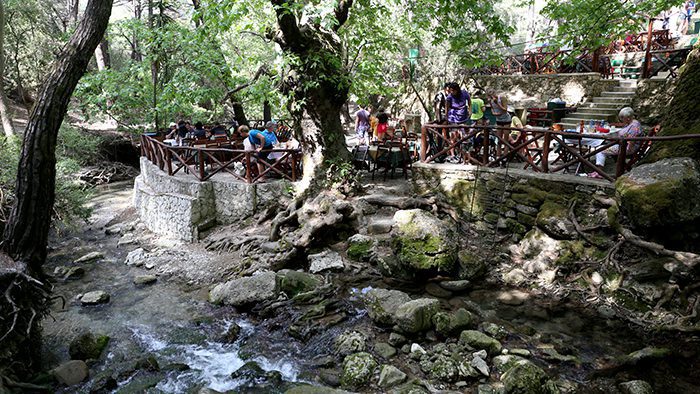
Nature lovers and families will enjoy an afternoon in Seven Springs (Epta Piges). Located in a small patch of lush forest in the heart of the island, just a short drive away from Kolymbia, these natural springs trickle down into one another down the forest floor. The sound of rushing water provides a pleasant soundtrack to an easy hike through the area. Those daring enough to try can follow the narrow, dark tunnel to the lake where the spring water collects. When you’ve worked up an appetite, head to the charming taverna at the entrance of the park, where you can dine al fresco by the flowing springs.

Tip: When visiting Seven Springs, wear comfortable shoes and/or water shoes if you plan to go through the tunnel that leads to the lake. The Seven Springs are located in a shaded forest. There may be mosquitoes lurking, so bring insect repellent. If you plan to swim in the lake, you’ll have to bring your own towel, as there are no facilities there.

Other points of interest near Seven Springs include Tsambika beach, Mountain, and the Tsambika Monastery that rests on its upper slopes. The monastery is shrouded in local legend. The Byzantine church at the top is dedicated to Our Lady, and a revered historical site for the women of the island. Women with childbearing problems are encouraged to make the ascent barefoot and pray to the virgin in order to receive the blessing of children. Upon the birth of her divinely gifted child, she is to name him Tsambiko, or, provided it is a girl, Tsambika. The monastery can be reached via a five-minute drive from town. Be sure to bring plenty of water and wear sunscreen. Please note that there is a fairly steep, moderately difficult ascent of over 300 steps. However, the reward is definitely worth it. From the top you will have incredible panoramic views of the coastline from Kolymbia to the town of Lindos.
Constructed by the Byzantines in the 12th century, Lardos is one of the island’s top historical sites. When the Knights of Saint John arrived in Rhodes, they were thrilled to find the castle in need of only minor reparations and otherwise ready for occupation. Less than a year later, both the castle and the entire settlement of Lardos were gifted to the revered Genovese admiral, Vinioli, by none other than the Grand Master himself.
The Lardos Castle is just half a kilometer from Lardos village. The road leading up from Lardos is clearly marked. The castle has fallen largely into disarray and much of the site is overgrown with vegetation. Regardless, its secluded location crowning the peaceful hilltop makes for a unique experience and the views of Lardos town are unparalleled.
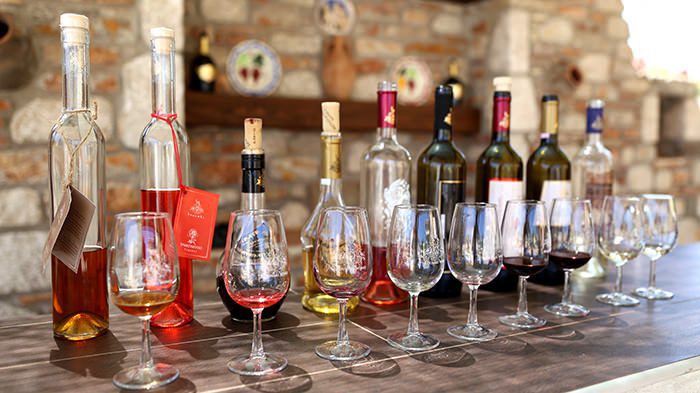
The region’s rich volcanic soil grows fruit, olives, and tobacco. However, it is best known for its wine. Winemaking has existed on the island for over 2,400 year! Emponas is a must-visit for every gastronome. Affectionately referred to as “the wine town,” Emponas is a charming mountain village with a population of about 1450 people – the perfect place to pass a day in relaxation getting acquainted with the local wine. Nestled in the foothills of Mount Atavyros, it has formed the capital of Rhodes’ wine production for centuries. The countryside is littered with verdant, family-owned wineries that still produce wine true to the island’s viticulture traditions.

Many Rhodian wines come from the regional grape variety, Athiri. All efforts to cultivate Arthiri grapes off of the island have failed, so wine connoisseurs should relish in the opportunity to try truly one-of-a-kind Rhodian wines! Kounakis Winery is an excellent place to start your wine tour. Family owned and operated since 1928, Kounakis Winery produces over 20,000 bottles a year and follows the traditions of great-grandfather and founder, Kyriakos Kounakis. In addition to Athiri, Kounakis makes Syrah, Chardonnay, Merlot, and Mandilaria (Amorgiano). Wine tastings are free, and there’s no pressure to buy. If you would like to set up a tasting for a group contact the winery directly at Kounakiwines@gmail.com.
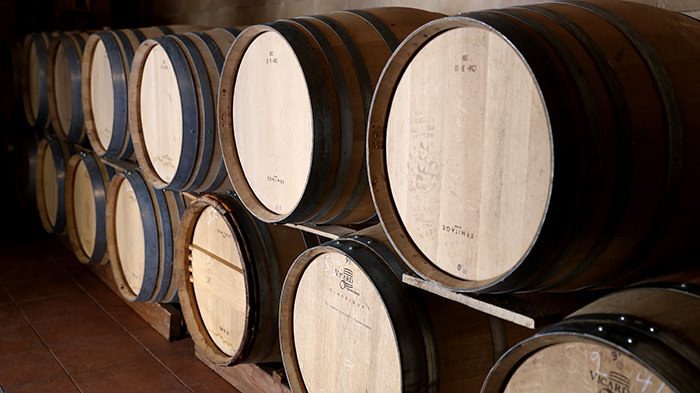
Other local wineries worth a mention are Alexandris Vineyards (Contact Panagiotis on his cell +30 69377 57831) and the Mercouris traditional winery (+30 22460 41243), which has been around since 1935. You could also check out the largest of the bunch, Emery Winery, which has been around since 1923 and is owned by the Triantafillou family. After swishing, sniffing, and sipping to your heart’s content, purchase a few bottles of your favorites to take home or enjoy back at your hotel. The average price per bottle is an irresistibly economical €10. When hunger strikes, head to Taverna Savvas for a delicious Greek barbecue and more wine, if you wish.
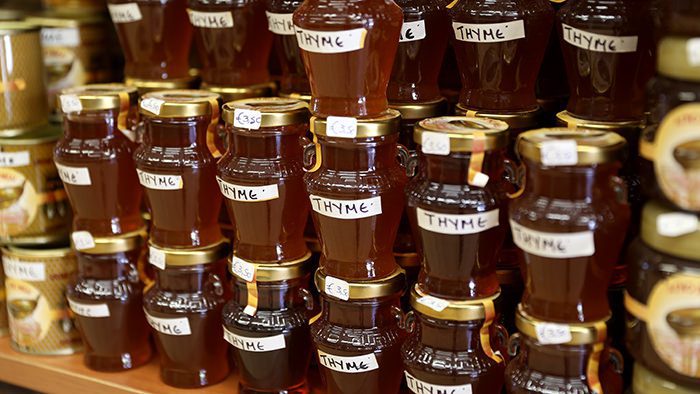
Emponas enjoys close proximity to yet another of the island’s gastronomic gems. Just a short distance down the road is the charming town of Siana. Known as the “honey village” these Rhodians have truly mastered the art of jarring nature’s favorite sweetener. All along Siana’s main street there are a number of places that offer up free samples of the various flavors. Thyme honey is a local favorite and makes for a great foodie souvenir. One of our favorite shops in Siana to buy local specialties is Tourist Shop Aris Karantzias.

Prasonissi is the southernmost point of the Rhodes. Brush sprinkled with wildly flourishing roses lines the road to this unique beach town. Situated where the Aegean Sea and the Mediterranean meet, the sea scenically approaches from both sides. It is a haven for lovers of any and all wind sports. The choppy waters of the western end tend to contrast the calmer and more welcoming waters of the eastern end.
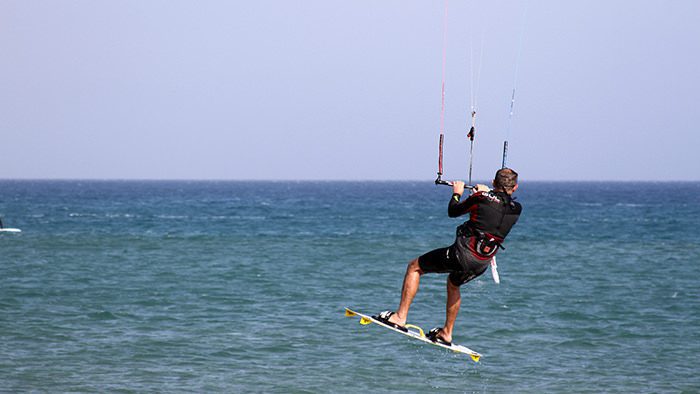
Accommodations are available, though few outside of the watersports’ enthusiasts tend to extend their stay beyond a daytrip. Cafés and restaurants abound. However, those heading to Prasonissi should consider stopping over for lunch in one of the hillside villages, Katavia or Arnitha.

In Katavia, there are a number of traditional tavernas and cafés that appeal to the transient tourist. After a tasty meal in the company of lounging locals, wander the back streets that make up the village, and enjoy some of the traditional Greek architecture. Arnitha is a sleepy hillside down. Welcoming in its somnolence, it is ideal for those who wish to stray from the trodden path and enjoy a bite to eat in true Rhodes’ fashion. The entrance to the village is marked by a drinking fountain amidst a shady courtyard. Sites worthy of a gander include the chapel located in the principal courtyard, Agios Nektarios, and the Monastery of Agios Filemonos. The town has a classic Greek charm to it that is best explored on foot-with a camera on hand!

Profitis Ilias is the island’s second highest mountain, and popular amongst visiting mountaineers, families, and nature lovers. Ataviros is the island’s highest peak, however its barren slope makes for a less appealing trip than Protifis Ilias’ lush winding roads. Most opt to see the mountain’s slopes while cruising the mostly well-surfaced roads that wind up to its peak. As you snake your way to the top, roll down the windows to take in the fresh mountain air. The mountain is well known for its seasonal diversity of colorful wildflowers, whose growth is naturally stimulated by the altitude.
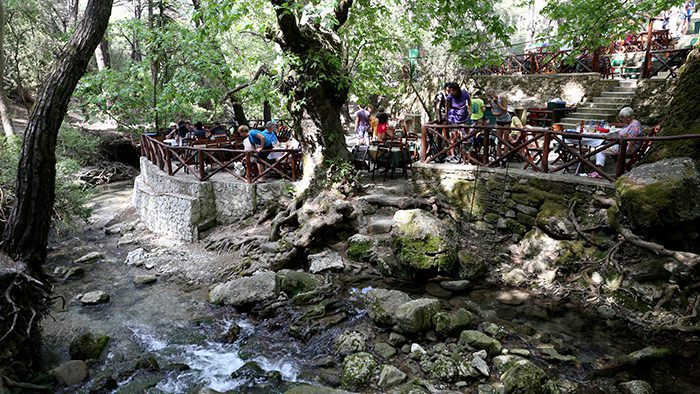
Those in need of a refreshing drink, some caffeine, or a quiet night’s accommodations, should stop over in the Elafos Hotel. Built in traditional Swiss Chalet style, the Elafos Hotel was once used as a resort for Italian officers during World War II. Since renovations were completed in 2006, the Elafos boasts 20 rooms and three suites. It is conveniently located near the monastery of Profitis Ilias. This peaceful property also makes for a peaceful weekend retreat.

The village of Monolithos is quaintly nestled at the base of Akramitis Mountain on the western coast of the island. Once one of the most impressive fortresses in Rhodes, the Monolithos Castle rests upon what is known as the Monoperta, a grey rock that appears as if it is ejecting itself out the side of the island. The highest point rises to an intimidating 775 feet. To reach the castle, drive along the coastal road that leads from Monolithos town.
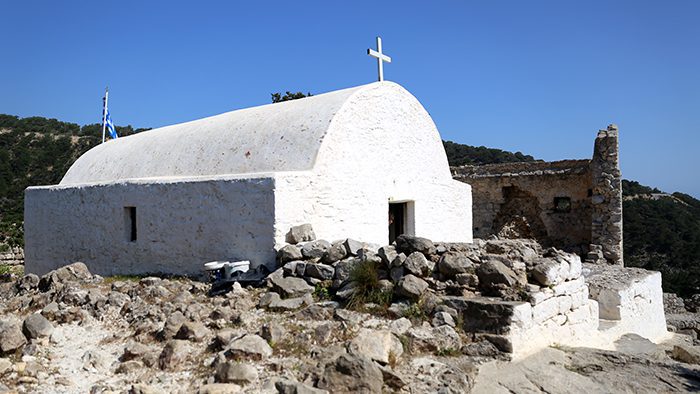
Jaw-dropping views accompany you all the way to the top. Parking is available below the fortress. Slick, narrow steps lead up to the thick impenetrable walls that envelope this impressively located crusader castle. Once inside, visitors will find the 15th century chapels, St. Panteleimon and St. George, as well as the remains of a previous castle composing the foundation of the present castle. The view from the fortress is sure to take your breath away. Unhindered views of the sea and the surrounding islets are back-dropped by the mountainous terrain and the village of Monolithos in the distance. The castle is open daily and admission is free.

Thirty-six miles from Rhodes Old Town is the captivating town of Lindos, which along with Ialyssos and Kamiros, forms part of the three principal ancient cities of Rhodes. Tourists head to Lindos for two reasons: the fine, white shoreline, and the town’s crown jewel, the 4th century Lindos Acropolis that hovers impressionably over the town. While it is possible to reach the acropolis on foot, most people prefer to hire a donkey (€5 each way) for the steep ascent. Open 8:30 a.m. to 2:40 p.m. every day except for Monday, the Acropolis is home to the Temple of Athena, which dates from 300 B.C., though many of the site’s other ruins tell a different tale.

Over the years, contributions were made by various empires: Greek, Roman, Byzantine, the Knights of Saint John, and Ottomans. For example, one of the site’s most recent constructions is the Greek Orthodox Church of Saint John dating from the 13th or 14th century. It is just one of the constructions that make excavations complicated since its covers the ruins of an even older church that dates as far back as the 6th century!
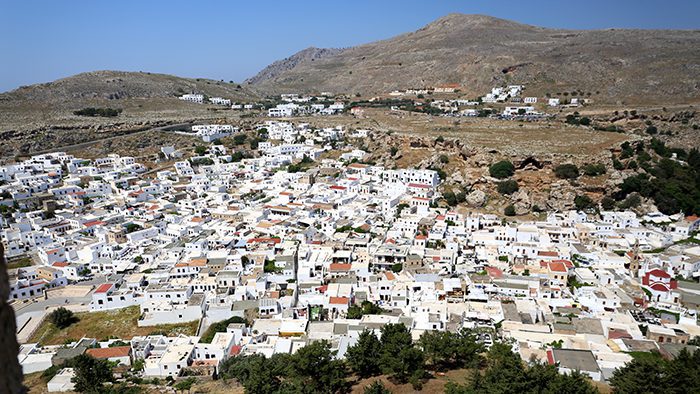
When in Lindos, also make time to see the Church of the Panayia off the main square (about two minutes walking). Originally built in 1300, the Church of the Panayia is a beautiful structure that features a bell tower, courtyard, a red tile roof, and pebbled mosaic floors. Step inside to admire the fresco of The Last Judgment, 18th century painted icons, impressive bronze chandelier, and the vaulted ceiling. Additions were made to the building throughout the centuries, the most notable ones made by Grand Master Pierre D’Aubusson (1476 – 1503).

Lindos is one of the three most visited destinations on Rhodes, next to Rhodes Old Town and Faliraki ( Anthony Quinn Bay ). Many tourists hit the town during the wee hours of the morning as part of a tour. If you have your own transportation, try sticking around into the later hours of the afternoon to get a true feel for Lindos’ small-town essence. Enjoy one of the local eateries, wander the narrow alleyways by foot, and watch the sunset over the bay. Music lovers, please note that Lindos hosts one of the most sought out classic rock festivals in Europe. If you are looking for a party and have an affinity for the classics, consider checking out this year’s dates for the Lindos Rock Festival that is held annually during the summer months.
Book a Half-Day Tour of Lindos here!
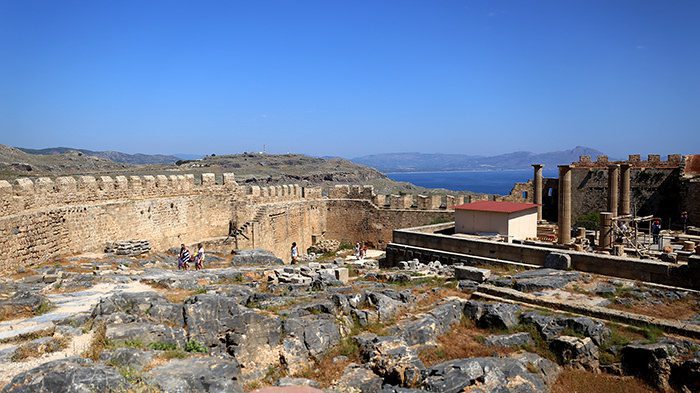
Tip: even if you plan to ascend the Lindos Acropolis with a donkey, wear comfortable shoes and plenty of sunscreen. The weather is Rhodes is almost always hot, and the sun is quite unforgiving.
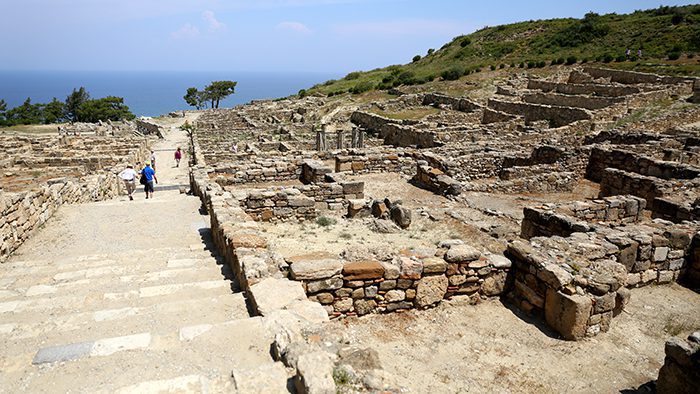
Ancient Kamiros sits along Rhodes’ western coast. Once a large Doric city, it eventually fell into decline as its residents began to relocate to Rhodes Town circa its inauguration in 408 B.C. Excavations of Kamiros began in 1929 and continued until the end of World War II, after some ancient graves were accidentally uncovered. Historically, Kamiros was dependent upon agriculture. Oil, wine, and figs flourished in the area, and in the 6th century, the city became the first Rhodian city to mint its own coins. The city was built on the concave slope of the northwestern shore and divided into two distinct areas.
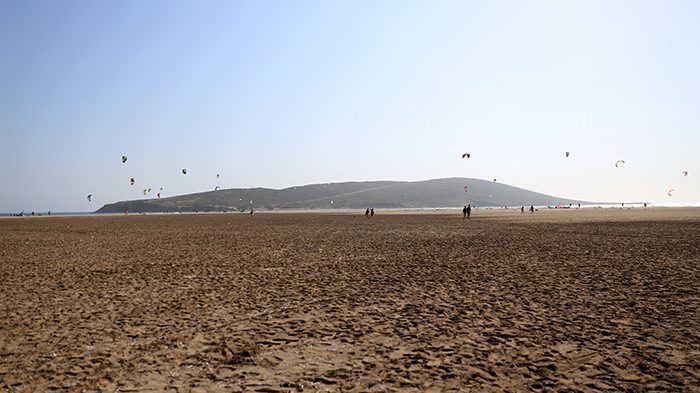
Residential buildings and housing developments occupied the lower half of the slope in what is considered to be the finest layout of an ancient Greek neighborhood. Remnants of the impressively advanced drainage system can still be seen today. The upper area was dominated by the town’s impressive acropolis. Points of interest include the fountain-adorned sanctuary that greets guests, the sacrificial area, the Sanctuary of Altars, the 6th century B.C. cistern that occupies the highest point of the town, and the remains of the Athena Kamiros temple. For an unparalleled view of the city, head up to massive 3rd century stoa located behind the cistern.

Of the three ancient cities, Ialyssos lies closest to Rhodes Town and remains the island’s second largest city. It is a major tourist attraction for its numerous resorts, restaurants, and cosmopolitan feel. Additionally, the nearby town of Ixia has become a site of increasing tourism interest in recent years. No visit to Ialyssos is complete without a visit to the ancient remains of the original city, which was initially occupied by the Phoenicians. Like all of Rhodes’ ancient cities, ruins reveal influences and contributions from a series of empires. Excavations revealed Mycenaean tombs, a Doric fountain with four impressive lion heads, and a large temple dedicated to Zeus and Athena Polias.
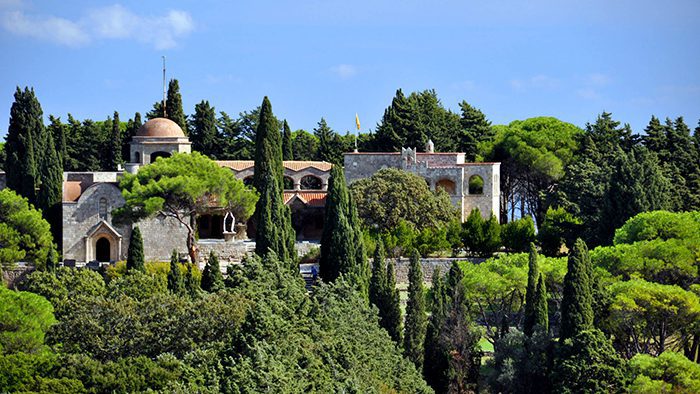
The acropolis is one of the later constructions. The Byzantines employed it for military purposes in 1248, and the Knights later improved the fortress by making renovations and constructing both a monastery and church. The monastery was later restored by the Italians, and is currently the best conserved construction, complete with courtyards and dwellings. Highlights of ancient Ialyssos are mainly located along the inclining avenue that begins directly at the site’s entrance. Additional sites of interest include the reconstructed Church of Our Lady of Filerimos, and the underground Byzantine chapel, Agios Georgios. The notably well-conserved 11th century castle of Ialyssos rests atop the hill and serves as a rewarding conclusion to the ascent.
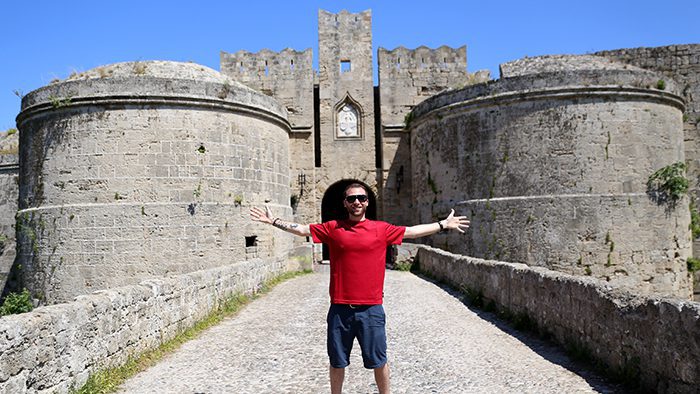
If you’ve thought about taking a trip to the Greek islands, Santorini or Mykonos may have crossed your mind. Both islands are wonderful, but if you can get over the images of whitewashed villages and blue shutters, you could be just as satisfied vacationing in Rhodes, and for a lot less money. Rhodes has the advantage of being big enough to hold your interest for more than just a few days, but small enough to conquer by car. I spent eight incredible days exploring the island, and there were still things I didn’t have time to see. What makes Rhodes unique is Rhodes Old Town – a wonderland of history, architecture, and legend.
Aside from Malta, nowhere else will you see the extraordinary buildings left behind by the Knights Hospitaller. But the Knights weren’t the first to contribute to the island. You could spend your days leisurely exploring ancient Greek ruins in Ialyssos, Kamiros, or Lindos. Rhodes also has a wide range of beaches, from the lively shores of Faliraki, to the serene atmosphere of Kolymbia Bay. Foodies will also be spoiled for choice. Rhodian food is renowned for its freshness and superb quality, and the local wines pair perfectly with the grilled seafood and traditional recipes. I highly recommend renting your own car so you can get to visit southern areas like Prasonissi and Monolithos. Plus you’ll save money because taxis here can get expensive. Overall, Rhodes is a great all around destination to base yourself out of for a week or more, and if you plan to continue exploring the Dodecanese Islands. Direct flights from Athens and Thessaloniki also make it easy to get there.
Official name of Greece: Hellenic Republic, also referred to as “Ellada”
Population of Greece: 11.3 million (2013)
Population of Rhodes: 120,000 (2012)
Time zone: GMT +2
Language: Greek
Tours: Check out some more tours here!
Currency: Euro (€)
Currency converter: XE
Getting there: You can get to Rhodes either by ferry or air. Direct flights are available with either Aegean Airlines or Olympic Air from Athens, Crete (Iraklion), Karpathos (Kasos), Kastellorizo, Mykonos, Santorini, and Thessaloniki. Dozens of buses shuttle passengers from the airport to Rhodes Town throughout the day.
Need a private airport transfer? Book it here!
When arriving by ferry, you will dock at Mandraki Harbor in Rhodes Town. Ferries are available from Athens, but keep in mind that this is roughly a 16-hour journey, as opposed to a 50-minute flight. Ferries are also available from the surrounding Dodecanese Islands of Astypalea, Chalki, Kalymnos, Karpathos, Kassos, Kos, Leros, Lipsi, Megisti, Nissyros, Patmos, Symi, and Tilos. Services from the Cycladic Islands include Amorgos, Milos, Santorini, and Syros. Services between islands run regularly during high season. However, those visiting during off-season should be prepared to contend with a drastically restricted ferry service. Both Dodekanisos Seaways and Blue Star Ferries have routes to Rhodes.
Getting around: Aside from Rhodes Town, Rhodes is not an island you can see on foot. If you wish to explore beyond the northern tip, you will need wheels of some sort, whether you choose to take the public bus, hire a taxi, or drive yourself.
We believe renting a car is the best way to get around. However, there is a reliable public bus system. Unfortunately, tourists may find that it does not run as frequently as they might like, that being particularly true for the winter months when it could be argued that the bus system is all but impractical. Taxis are also a viable option, though visitors may be hard-pressed to hail one on a Sunday. Please note that tipping your taxi driver is customary and expected!
Since many of the villages can be explored on foot, do not forget to bring along a pair of comfortable walking shoes, sunscreen, light clothing for summer months, and a wide-brimmed hat.
Business hours: The first challenge about shopping in Rhodes is getting to know the odd Greek working hours. Post offices are only open Monday to Friday from 7:30 a.m. to 2 p.m. Banking hours are equally as limited, with standard hours of operation being Monday to Friday from 8 a.m. to 2 p.m., and Fridays from 8 a.m. to 1:30 p.m. These hours may be even further reduced in the smaller villages outside of high season. Fortunately, ATMs are commonplace. Bigger business, such as supermarkets and department stores, exhibit extended hours; Monday to Friday 8 a.m. to 8 p.m. and Saturday from 8 a.m. to 3 p.m. Standard business hours for pharmacies and many mom-and-pop shops are Monday and Wednesday 8 a.m. to 2 p.m., and Tuesdays, Thursdays, and Fridays from 8 a.m. to 8 p.m., with a break between 2 p.m. and 5 p.m. for lunch. Most local shops are closed Sundays. Regardless, touristy shops do tend to hold extended hours during summer months. Please note that many businesses close during winter.
Public holidays:
Shopping: Despite being on the mainland, there is no shortage of shopping in Rhodes. Rhodes Town has a wide variety of shops, boutiques stores, souvenir stands, art galleries, supermarkets, and convenient stores. Specialty items such as honey, jams, pastries, herbs, olive oil, and wines are available in towns and villages throughout the island. Rhodes has long been known for its fine jewelry – a local tradition dating back over five thousand years. Rhodes Town has contains over 50 reputable jewelry stores. Our favorite is Tzan Baltzi Jewelry (73, Hermou Street by Marine Gate) in the Old Town for its selection and crafstmanship. For original art, try the Alex and Maria Hohoy Art Gallery (42, Apellou Street – 15 Museum Square). The Kozas Art Gallery (98, Sofokli Venizelou Street) is another great place to find high quality, original pieces for your home or office.
Electricity: 220-240 Volts. Electrical sockets take the European 2-pin round plug. For 110-120 V (U.S. and Canada) appliances, a plug adapter, and in some cases a voltage converter is required.
Best time to go: Tourist season on Rhodes lasts from March to November. While weather is comfortable during the winter months, the island virtually shuts down after Christmas time, experiencing restricted public transportation to and around the island, as well as limited accommodations and dining options. June to September is the most crowded, the most expensive, and the hottest. For lower prices, less crowds and more comfortable temperatures, consider scheduling your trip during tourist season, but outside of Rhodes’ peak months.
What are your top 15 Things to See and Do in Rhodes Island? Leave us a question or comment below!
Special thanks to the Markopoulos Group of Hotels for hosting us during our stay in Rhodes.
Counter
101 Countries • 1432 Cities
Lilyan says:
Thanks for this! Heading there for 5 days in May and was at a bit of a loss now I have a full itinerary 😛
Nasser Amarin says:
Great info. Thank you . I am going to be their soon.
Gina says:
this is a great way to summarize Rhodes! i am going to link it to my travel website.
David says:
Thanks, Gina!